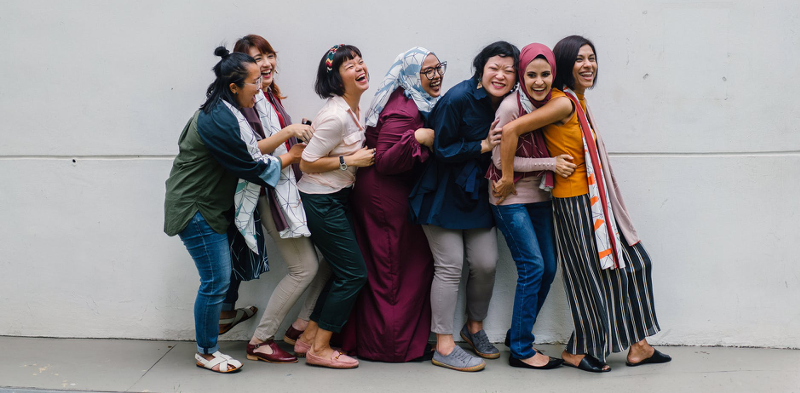By Mo Lewis, Prevention Specialist with the National Sexual Violence Resource Center (NSVRC)
In the prevention work I’ve done, I have been able to work with young people from so many different communities – and the one thing that remained consistent is that whenever I thought I had a pretty good guess as to the issues or topics they would care about and want to work on together, I was always wrong. Every time. This was humbling and a good reminder that even though we had a lot in common, I could not assume I knew what was best for them.
Building community partnerships is vital to our work – we need each other in order to create the kinds of positive change that will be long-lasting. We can’t do our work in silos. Meaningful collaboration is so important that it sometimes becomes just another thing on our list to check off – but what does that mean about the kind of relationships we are building? The prevention team at the National Sexual Violence Resource Center (NSVRC) has learned some lessons about building authentic partnerships and wanted to share some of these things with you.
Understanding power and privilege
“Power is the ability to decide what a problem is, to decide what needs to be done about it, to decide who will be included to solve it, in what capacity, and with what resources.” (Ruby White Starr, Caminar Latino, 2019)
Are you part of a large, well-funded mainstream organization that wants to build meaningful relationships with smaller, culturally specific and/or grassroots organizations or groups? Look back at that sentence and think about the differences between these organizations, and how those differences might impact relationship-building. I have been on the receiving end of invitations to “pick my brain” because I’m part of a marginalized group or have an identity that someone wants to reach, and it doesn’t feel good. It is tokenizing, especially if my role is to inform a process that I am not going to be part of. This practice has been referred to as “Trickle-Down Community Engagement,” which describes the lack of effectively engaging diverse communities in intentional, fully equitable and reciprocal partnerships. This happens “when we bypass the people who are most affected by issues, engage and fund larger organizations to tackle these issues, and hope that miraculously the people most affected will help out in the effort, usually for free” (Vu Le, 2015). It is our job to see and understand how power and privilege exist within our work, and how that will influence the way we build relationships. Which leads to…
Being transparent and sharing power
Why do you want to build this partnership? The reality is, our work keeps us really busy – and that sometimes means we only start building a relationship when we need something. Is it because you received or want to apply for certain funding? Is it because of a new requirement? It can help your relationship-building a lot if you are transparent about why you are choosing to reach out. Transparency can add clarity and lead to conversations about roles that each partner can fill. Sharing power in a partnership is important, especially because things like funding opportunities and access to resources are not always distributed equitably. Being able to speak openly about this, and plan together how best to work collaboratively, can be a great way to build and sustain a thriving relationship.
In order to build meaningful relationships and engage in social change, we must facilitate a more deliberate sharing of power and a commitment to understanding and dismantling structural racism and other isms. Ruby White Starr in Moving from the Mainstream to the Margins: Lessons in Culture and Power shares the following recommendations for power sharing and promoting racial equity:
- “Deepen your understanding of the intersections of oppression, privilege, and liberation.
- Recognize how racism and oppression impacts the issues you work on, underscore this impact in your tools, projects, and publications, and consider materials ineffectual if they do not explicitly account for the intersection of oppression.
- Take the lead from and partner with culturally specific technical assistance providers and communities that operate from an anti-racist foundation.
- Put important issues on the table, frame issues around the most marginalized, and put them to work in different situations when examining a problem, designing and implementing research and evaluation, considering policy, or developing interventions.”

Showing up and helping out
Regardless of how funding or requirements influence our relationship-building, one of the best things to do to build a relationship is to just show up. This means attending other organizations’ events and helping out by promoting their programs, without expecting or asking for anything in return. This is something we can start at any time, and as our relationships grow, we will learn new ways to work with each other.
This is just a start. There are many ways to engage and partner effectively and equitably. We look forward to learning and growing our work in this area and would love to hear the ways you build authentic and meaningful community partnerships.
For more information:
PreventIPV.org: This website offers a wealth of information to assist individuals and communities in building their capacity to engage in prevention work as it relates to gender-based violence. Included is a collection of resources such as training tools, campaigns, promising programs, evidence, policies, and other materials that can be adapted to advance your prevention efforts.
Creating Meaningful Collaborations Among Mainstream and Culturally Specific Programs: Drawing from both research and personal experience, this webinar explores effective components of equitable, mutually beneficial, and meaningful collaboration. Themes include authentic power-sharing and anti-oppression frameworks that center and elevate culturally specific communities.
How can movement building support our efforts for social change and collective thriving? In 2014, the Idaho Coalition Against Sexual & Domestic Violence began to lay a foundation for movement building. In October's TA Question of the Month, writers from the Idaho Coalition discuss their efforts to end patriarchy, sexism, racism, nationalism, classism, homophobia, transphobia, able-ism, audism, anti-Semitism, religious discrimination, and xenophobia/anti-immigrant sentiment through movement building.
How can we create meaningful connections with youth leaders seeking opportunities to become vocal advocates for themselves and their communities? Youth-led activism is an important part of the anti-violence movement. In NRCDV's February 2019 TA Question of the Month, Rebecca Balog and Tanae LeClaire from the National Indigenous Women's Resource Center explore ways that adult advocates can expose youth to technical skills and create spaces necessary for them to successfully navigate and impact the anti-violence movement.
Putting it Into Practice: Diversity and Inclusion in Prevention blog series from NSVRC partners. These blog posts highlight the important work being done to prioritize diversity and inclusion in prevention efforts.
- How North Carolina Prioritizes Diversity and Inclusion Across the State
- Sexual Violence and Oppression: Framing Our Work Using the Sexual Violence Continuum
- Why our Community-Level Prevention Efforts Must be Inclusive
- A Movement Within a Movement
- The Role of Language Access in Violence Prevention Efforts
- “We Can” Project: Incorporating Intellectual and Developmental Disabilities Communities into Prevention














